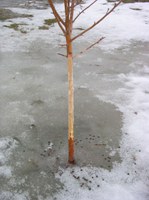Dakota Gardener: Give Your Trees a Little Winter Protection
(Click an image below to view a high-resolution image that can be downloaded)
By Joe Zeleznik, Forester
NDSU Extension
I have a confession to make.
Every fall, I’m hypocritical in regard to tree care. Generally, I don’t pamper trees; I’m tough on them. If they’re going to survive our challenging climate in the northern Great Plains, they’re going to have to do it on their own. Well, mostly.
But in the fall, I find that I’m always giving a little extra tender loving care to my apple trees. Specifically, I make sure that I somehow protect them from the rabbits. It’s a yearly battle against the rabbits. In recent years, I’ve been winning that battle, although it wasn’t always so.
The first apple tree that we planted in the backyard was a housewarming gift from a friend. And that first winter, I didn’t protect it and the rabbits completely girdled it. I was disappointed, but not heartbroken, because, let’s face it, we had only one year invested in the tree, and it would sprout from the roots just fine.
But I learned a valuable lesson, and ever since then, the apple trees receive some type of protection. I’ve usually used a white plastic pipe, but sometimes a wire fence goes up and I’ve even used the plastic wrap-type material. They all work fine.
This year, I’m going to have to protect some of the lower branches as well in case we get a lot of snow. I’ve seen rabbits destroy the tops of fruit trees in shelterbelts that had huge drifts.
Here are some more tree-protection techniques that you can use at home for your own trees:
- Add a white plastic tree protector on young and/or thin-barked trees to reduce the risk of sunscald, another type of winter injury.
- Give your conifers one final soaking before the soil freezes. This will help minimize winter injury, although it probably won’t stop winter injury completely.
- For small, high-value landscape conifers, consider using a burlap wrap or shield to reduce the chances for winter injury.
- Rake up and destroy leaves, especially those that had fungal problems this past summer. Fungi overwinter on fallen leaves, so getting rid of those infected leaves will reduce the potential for fungal problems next year.
- Prune dead wood to decrease overwintering sites for tree diseases and insect pests.
- Throughout winter, use caution when applying ice melt products – salt and other chemicals – around trees.
Winter is tough on trees, and I’m OK with that. But we have some things that we can, and should, do to make winters a little easier on them. Am I inconsistent? Maybe a little, but let’s face it – I love trees!
For more information about gardening, contact your local NDSU Extension agent. Find the Extension office for your county at https://www.ag.ndsu.edu/extension/directory/counties.
NDSU Agriculture Communication
Source: Joe Zeleznik, 701-231-8143, joseph.zeleznik@ndsu.edu
Editor: Ellen Crawford, 701-231-5391, ellen.crawford@ndsu.edu




